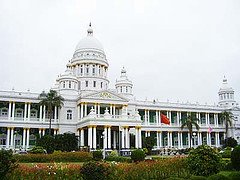Update Please look for
this post under business (I overlooked it before) and
this post under investing.
Here it is. Finally.
This took forever. I'm not doing this again - ever.
Thanks to Jay Solo for letting me host this and I apologize for not letting you know sooner that I was in India last week and was not going to be back before Jan 1.
Most of the posts were interesting but some were less so and I am very bad at hiding this. I could not resist inserting a bit of a comment in here and there but hopefully people will not be (too) offended. In general, these posts are well worth reading.
I tried to include everyone but I refused to look at the two posts labeled "sex" on the grounds that I am at home and my wife might have come in and found me looking at objectionable material. If I had done this a the office during company time, it might have been different.
I also refused to include one post that seemed to be merely a link to an online gambling site. I did include another similar post that made a half-hearted attempt to write a post about gambling simply because it was so pathetic it had humorous value.
If I forgot your post, I apologize. Please leave me a note. I'll probably forget it as well - but I assure you that it is nothing personal, I'm just that way.
Lighter Posts
These are posts that made me laugh or just didn't make my brain hurt.
Blog:
Interested Participant by Mike Pechar
Post:
Overstock.com Attacked by Sith LordFor some reason, Overstock dot com is seeing sales fall and its stock price plummet. Is the reason possibly related to the fact that the CEO thinks that a "Sith Lord" is plotting to overthrow the company? This is a thoroughly entertaining piece and perhaps a warning not to entrust your company to your not-so-reliable son.
Blog:
Big Picture, Small Office by Big Picture Guy
Post:
In Wine There is TruthThe author relates a humorous anecdote from a company party and finds that too much wine can "deconstruct" the office toady. We all know people like that.
Blog:
Political Calculations by Ironman
Post:
The Perils of MarketingThe author gives a list of humorous marketing mistranslations. Compare with
this list from
Snopes.
Blog:
Multiple Mentality by Josh Cohen
Post:
“Holiday” “Spirit”Here is a nice light rant against the half-hearted attempts retailers make to subtly market Christmas without offending non-Christians. This post reminded me of
another post by
Sepia Mutiny (an excellent blog).
Economics and Regulation
Blog:
Sophistpundit by Adam Gurri
Post:
What Can We Hope to Leave Our Children?The author asks a big question: will the future better better or worse for our children? He clearly believes that it will be better and that there is no reason to fear "peak oil" or any other exhaustable resource will stop our growing prosperity. This is a thoughtful post.
Blog:
The Roth & Company Tax Update by Joe Kristan
Post:
The Tax Gap and the Schmuck FactorThe author fears that lax enforcement of tax laws will lead to more people cheating on taxes and other people feeling like "schmucks" because they didn't cheat and their neighbors did and got away with it. Over time, the "schmucks" will learn to cheat also.
Blog:
Daily Dose of Optimism by Ed
Post:
Against Public Sector UnionsThe author takes a hard look a public sector unions, and the potential problems they pose to the economy through higher taxes. There are some interesting economic and moral issues raised by the potential conflict of interest between government and government employee unions.
Blog:
Different River by Different River
Post:
They’re All Wrong!The author doesn't want to take sides on the new California law regulating violent video games: the author thinks that all sides are wrong. This post raises an interesting question about what is the appropriate regulation of violent video games.
Blog:
Chocolate and Gold Coins by Michael H. (me)
Post:
Signs of India's DevelopmentThe author (me) compares the India he saw in 1995 to India of 2005 to see signs of development. India is developing but trend is subtle. India is a great place to visit, by the way.
Blog:
Gongol by Brian Gongol
Post:
Ages of the World's Largest Companies Here is an interesting hypothesis: does more government regulation mean that older established firms have an unwarrented advantage in the marketplace? If so, the average age of firms should be higher in more regulated economies. Here is some evidence.
Blog:
Marketplace Monitor by Chris Rossini
Post:
Why so down on Dividends? The author argues that the double taxation of dividends encourages firms with profits to make unwise purchases of other companies.
Blog:
Searchlight Crusade by Dan Melson
Post:
The Economics of Housing DevelopmentThe author believes that we spend too much on housing and gives a long and detailed explanation for why this is so. People who like this post might like to read
this book.
Investing
Update - I forgot this oneBlog:
All Things Financial by JLP
Post:
Making Financial Resolutions for 2006The author gives a list of financial resolutions you should follow for the next year. Indeed, if you do not follow number 2, Santa will put coal in your stocking next Christmas (and you'll need it to heat your home).
Blog:
Personal Finance Advice by Jeffrey Strain
Post:
The Worst Investments You Can Make Here is a nice post listing some of the really bad investments people might make. People in India might want to consider the advice about not investing in jewelry. My wife's family invested a fortune in buying jewelry in anticipation that she would eventually have a traditional Indian wedding. It still languishes in some safe deposit box.
Blog:
Econbrowser by James Hamilton
Post:
Who's afraid of the big bad yield curve?The author provides some detailed analysis of the link between interest rate inversion (short term rates higher than long term rates) and economic slowdown. The former doesn't always predict the latter, but there is correlation, (nice graphs).
Blog:
Financial Methods by Michael Cale
Post:
Will 2006 Be the Year of Japan?The author provides some nice graphs to show how well the Japanese stocks performed in 2005. He believes this might be a harbinger of strong economic growth in Japan in 2006. He believes "2006 could be the Year of Japan for equity investors." Either that or 2006 is the year investors invest in Japanese equity a year too late.
Blog:
Small Business Trends by Anita Campbell
Post:
Top Ten Promising Small Business Opportunities for 2006The author provides a list of what she clearly believes will be the hot new business opportunities for 2006. If you are a contrarian, this is the list of business to avoid or sell short. Something for everyone here.
Blog:
Capital Chronicle by RJH Adams
Post:
The Baltic Dry Index: 'I fear thee, Ancient Mariner!'The author shows some nice plots comparing the rates on 10-year Treasury notes and the Baltic Dry Index (a shipping rate index). The author feels that maybe equity investors ought to be paying more attention to what shipping rates are doing, as reflected by the Baltic Dry Index.
Blog:
Mover Mike by Mike Landfair
Post:
Gold Mining and Non-Recourse LoansThe author looks at the merger between two gold mining companies and discovers that much of their gold is presold at below current market prices. They will not be able to fully profit from any future price increase as well, (of course, this also means they won't lose as much if the gold bubble bursts).
Blog:
Early Riser by Early Riser
Post:
401k Versus Roth - A New ER Ratio!The author provides some calculations to help you determine whether you would be better off investing more in your 401k or in a Roth IRA. Basically, it depends whether your marginal tax rate is going to be higher or lower at retirement than it is today.
Blog:
Free Money Finance by FMF
Post:
Getting Rich is Simpler than You Think The author believes that getting rich is easier than you think: just save a portion of your income in mutual funds and compound interest will grow your investment. This is undoubtable true if "getting rich" means accumulating about $100,000 to $200,000 in wealth (remember what you paid for this advice).
Blog:
Financial Options by Tom Hanna
Post:
Market Wrap 2005This year the Dollar was up 11% against the Euro, Gold was up 20%, the Dow was down 0.5%... If you like this sort of thing, this post provides lots of statistics.
Business and Business Practices
Update - I forgot this one (sorry!)Blog:
Okdork by Noah Kagan
Post:
Death of a Startup: Online Video Sharing WebsiteThe author gives an interesting account of what went wrong in a startup involving online videos. Even the combination of a great idea and talented people doesn't guarantee success.
Blog:
Businesspundit by Rob
Post:
Should You "Spy" On Employees Through Social Networking Sites?The author gives an interesting example of how one manager found out a whole lot of potentially damaging information on his own employees by logging on to a social networking site. The author asks: "Is this ethical?" Um, no. Are businesses going to do it anyway? I wonder.
Blog:
InsureBlog by Henry Stern
Post:
Death of a Salesman (and his business)Here is something many small business owners never consider: what happens if the owner dies? Often, the business dies also, even if it was profitable and has several employees. The author argues that a simple buy-sell agreement would likely prevent an unfortunate demise of a good small business.
Blog:
Fire Someone Today by Bob Pritchett
Post:
Sorry, we're closed...The author reminds us that it is never good business to close ten minutes earlier than the posted closing time.
Warning: it might not be a good idea to read the blog titled "
Fire Someone Today" at work.
Blog:
Photon Courier by David Foster
Post:
Railroads: The Next PhaseThe author gives a thoughtful and detailed look at the next generation of railroad technology.
Blog:
The Big Picture by Barry L. Ritholtz
Post:
Annual CD Sales Slide Resumes; Down 8% for '05The author looks at sales of CD's a discovers an unmistakable downward trend. It could be those MP3 players. The author adds a rather amusing observation about Mariah Carey and her success in recording No.1 hit singles.
Blog:
Kicking Over My Traces by cehwiedel
Post:
A Little Analysis, PleaseThe author does some nice and simple analysis of data from BigStockPhoto and quickly concludes that not many photographers are using commission sales from BigStockPhoto as their sole source of income.
Blog:
Blueprint for Financial Prosperity by Jim
Post:
Ten Real Estate Mistakes The author offers some sound advice for people looking to buy a new home. Curiously "location" only shows up at number 7 under "remember the little things."
Blog:
Crossroads Dispatches by Evelyn Rodriguez
Post:
Teach Him to FishThe author takes a look at charities that helped in the wake of last year's tsunami. She finds that the ones that were most effective combined donations with skill building.
Blog:
The Browster Blog by Scott Milener
Post:
The Click Fraud EffectThe author looks at the problem caused by fraudulent clicks on online advertisements. The author feels the problem might be cured by combining a price per action (a sale) with a price per click. This post left me wondering what exactly is "
click fraud".
Blog:
Ego by Martin Lindeskog
Post:
Highflying BusinessThe author looks at the success of Budapest (Hungary) Airport. Perhaps it is related to deregulation/privatisation of Hungary's airlines.
Blog:
Mensa Barbie Welcomes You by Mensa barbie
Post:
Interdependent OutsourceThe author gives her (or his) opinions on outsourcing. The author seems to be concerned that outsourcing will lead to loss of skill in our country (I'm guessing). I admit that I don't think I understood whatever the author wrote. Maybe I should have outsourced this task to India.
Blog:
Online Casino Bonuce by Alexander Volskov
Post:
Casino GamesThe author provides a brief history of casino games. I am suspicious that the real motive of this post is to entice readers to click on his links to online gambling.
Sales and Marketing
Blog:
The Common Room by DeputyHeadmistress
Post:
Buying the GuitarThe author gives her experience with two different musical instument stores. One store made no effort to sell anything, the other did.
The Common Room is actually a very good blog and in might be worth a second look. I might be biased: they recently linked to
this post of mine.
Blog:
Business & Technology Reinvention by David Daniels
Post:
Paying for Performance and Customer ServiceThe author provides his own experience shopping for a computer for his father at three types of stores: Full service, discount, and warehouse. He found that the discount store provided more helpful service in part because their sales staff are on commission and not pure salary. Compare with the previous post.
Blog:
Blog Business World by Wayne Hurlbert
Post:
Blog visitor traffic: Boost your readership numbersHere is some advice in bringing some more visitors to your business related blog. Good advice but I would add one more: make sure your content is worth reading.
Blog:
Pro Weblogs by Mariano Di Biase
Post:
How to carve for a niche blog for tomorrow, today This post explains why it is important to start early if you plan to start a blog with a finite lifespan (e.g. a blog on the 2006 Soccer World Cup). This blog is published in both English and Spanish.
Blog:
Small Business Branding by Yaro Starak
Post:
Small To Medium Business BrandingThis post explains the need to protect your brand when a solo enterprise transitions to a multi-employee enterprise.
Blog:
Lip-sticking by Yvonne DiVita
Post:
Jane Markets BlogsThe author gives credit where credit is due, and points out the human-value in blogging. The author gives an end-of-year thanks to all of her blog buddies - a nice thought. I should give an end-of-year thanks to my blog buddies:
Sunil,
Vikram,
Charu,
Amit, and all those other people on my blogroll.
Politics
Blog:
The Skeptical Optimist by Steve ConoverPost:
Reflections on 2005, and a list of things I’m notThe author explains why political labels like "libertarian" "supply-sider" "left-wing" or "right-wing" don't accurately describe his views.
Blog:
Don Surber by Don Surber
Post:
Bush Cracks Down On White Collar CrimeThe author believes that President Bush is doing a significantly better job of cracking down on white collar crime than his predecessor. This post made me wonder what would have happened to Osama Bin Laden if, in addition to his other crimes, he embezzled a company.
Sneek Peek at Next Week
I will be submitting the answer to
this question.






